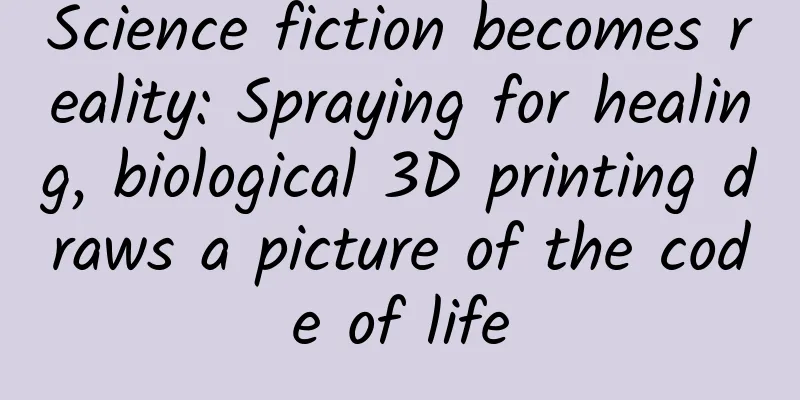Science fiction becomes reality: Spraying for healing, biological 3D printing draws a picture of the code of life

|
Recently, due to the exposure of the 315 news, the food that everyone least wants to see is pickled cabbage, which is so delicious that it even makes people feel a little PTSD. Seeing the dozens of ancient drying processes, what comes to mind is a pair of big feet pickling it specially. Various foods related to the pickled cabbage series, such as instant noodles and pickled fish, have been severely affected, implicated many companies. But what is strange is that during the period when most instant noodle companies were damaged, White Elephant instant noodles unexpectedly became popular and sold out. The sudden attention to Baiyang stems from a short video that revealed that one-third of Baiyang's employees are disabled. Baiyang's market share is not high among instant noodle companies, but it has recruited one-third of its employees who are disabled, truly extending its social responsibility to the people who need it most. This value has been recognized by countless consumers, so it is no wonder that everyone has started wild consumption again. According to data from the World Health Organization in November 2021, more than 1 billion people in the world suffer from disabilities, and with the trend of population trends and the increase in the number of patients with chronic diseases, the number of people with disabilities is also increasing year by year. In the past few years when the COVID-19 pandemic was prevalent, the lives of people with disabilities have been greatly affected. This vulnerable group has been neglected because of its limited voice. Due to the domestic disability infrastructure and concepts, the daily life of people with disabilities is very difficult, and cold treatment and discrimination are everywhere, not to mention participating in the chain of social value and contributing. According to data from the China Disabled Persons' Federation, as early as 2010, the number of disabled people in China exceeded 85 million. Now, the number is even larger, and it is estimated that the number exceeds 100 million. They are facing a more difficult situation than us. Among these people, congenital disabilities are only a part, and acquired disabilities are everywhere. Among the disabilities, there are deafness and blindness, paralysis and aphasia, and various functional disorders. No matter what kind of disability, there are many challenges in daily life. The development of science and technology and the continuous progress in the field of biomedicine have brought breakthroughs in the diagnosis and treatment of some disabilities. Recently, a treatment plan for paralysis has brought good news to millions of paralyzed people. Liberate your body Do you still remember these shocking news: some people were paralyzed due to spinal injuries caused by falling while playing in trampoline parks, and some people were paralyzed in the lower body due to the spinal injuries caused by the bent waist posture when learning dance. In real life, accidental falls, traffic accidents, improper exercise, etc. will all lead to the risk of paraplegia and affect the quality of life. It is reported that there are millions of people in the world who are paralyzed due to spinal injuries, nerve cell damage, nerve fiber rupture, spinal cord transection, etc. There is still no effective treatment for patients. Once paralyzed, it means being confined to a wheelchair for life, which is very depressing. The new therapy uses 3D bioprinted tissue to treat spinal cord injuries, bringing hope to people with spinal cord injuries. In animal tests, this new therapy can restore the ability to walk in 100% of early paralyzed mice and 80% of long-term paralyzed mice. This new therapy comes from the collaboration between scientists and regenerative medicine companies. A research team led by Dr. Tal Dvir from the Sagol Center for Regenerative Biotechnology at Tel Aviv University in Israel, in collaboration with Israeli regenerative medicine company Matricelf, developed a 3D printed spinal cord tissue implant that can effectively repair a broken spine. Researchers have proposed a variety of methods to connect the injured spinal cord, such as transplanting different types of cells or biomaterials to the damaged site during the acute injury period. Various cell transplantation therapies, including neural stem cells and neural progenitor cells, have been tested. 3D bioprinting technology can simultaneously print the patient's cells and extracellular matrix to produce living tissues and organs. The researchers used the extracted extracellular matrix to produce a personalized hydrogel that would not trigger an immune rejection reaction after implantation. Encapsulating cultured stem cells in a hydrogel can simulate the embryonic development of the spinal cord and then become a 3D neural network implant containing motor neurons. In a comparative experiment, the researchers implanted the new 3D neural network implant into recipient mice, which quickly repaired the damaged spine of paralyzed mice. Ultimately, all the acutely paralyzed mice that received the transplant regained the ability to walk, and 80% of the mice in the long-term paralysis mouse model also regained the ability to walk. Regarding the application of this technology in the human body, it is reported that Matricelf is now actively communicating with the US FDA and is preparing to enter human trials through its 3D printed spinal cord implants by the end of 2024. Humans may only be a few years away from curing paralysis. Just think, in a few years, millions of people can benefit from this technology and regain their limb freedom, which is exciting. Tissue damage and degeneration are common phenomena for the human body. However, in the face of some serious trauma, the human body's regenerative ability cannot cope with it and cannot achieve self-healing. The use of 3D printing biological tissue technology can also bring new solutions to the transplantation of some tissues and organs. "Blooming" breakthroughs in multiple fields Thanks to the rapid development of tissue engineering and regenerative medicine, 3D bioprinting technology is currently one of the most advanced technologies in the field of medical tissue engineering. It includes the most advanced technologies in materials science and biotechnology, and has been used to manufacture replacement and repair of damaged tissues and simple organs. 3D bioprinting technology is similar to ordinary 3D printing technology, both of which use a top-down, layer-by-layer construction method to generate complex and precise three-dimensional structures. The difference is that the ultimate goal of 3D bioprinting technology is to build tissues or organs layer by layer. For 3D bioprinting technology, the key is to design the model of printed organs and select bio-ink. Take bio-ink for example, it is usually a composite material composed of biological materials, cells and other necessary components. Since this technology can be used to manufacture functional human tissues or organs, such as heart, liver, skin, bones, etc., therefore, achieving and maintaining the activity and function of bio-ink materials is the key to this technology. (3D printed fully vascularized mini human heart) In terms of organ transplantation and tissue transplantation, there are solutions such as 3D organ printing technology, iPSC technology and xenotransplantation. These different solutions have their own advantages and disadvantages and are used to solve different transplantation and treatment needs. In comparison, 3D organ printing needs to solve the limitations of bio-ink, xenotransplantation still needs to solve the problems of immune rejection and animal endogenous viruses, and iPSC technology is still difficult to achieve organ construction. These solutions and technologies are developing in parallel in their respective fields, all of which are solving the problem of insufficient organ transplant donor resources. In actual clinical applications, 3D bioprinting technology has also made many new breakthroughs. Recently, the orthopedic team of Shanghai Ninth People's Hospital in China pioneered a new type of 3D biomaterial printing technology, which extracts the patient's own cells to simulate the bone material that needs to be implanted. The printed bone material will be transplanted into the human body, and the bone cells will play a bone fusion effect, and the growth and recovery will be faster and more efficient. It is said that this technology has been used in three clinical operations worldwide so far, all in Shanghai Ninth People's Hospital. In addition to its clinical applications in the medical field, 3D printing technology can also be used in drug trials, surgical training and environmental protection in the medical field. An institute led by Anthony Atala from the United States has developed a new biological tissue using 3D printing technology that can test the toxicity of drugs, and this technology has also been used in research experiments to test the toxicity of drugs against the new coronavirus. In the environmental protection scenario, some researchers have tried to use 3D bioprinting technology to create bionic 3D printed corals. As a new tool for coral-inspired biomaterials, it can be used in algae biotechnology, coral reef protection and coral-algae symbiosis research. Whether in clinical medicine or beyond the scope of tissue engineering and regenerative medicine, the application of 3D bioprinting technology is trying to open new doors in these fields, connecting previously slow and stagnant research areas with new opportunities and possibilities. Next stop: Printing life We can see that in the past two decades, many biological 3D printing technologies have been developed and applied in many biomedical fields, including tissue engineering, disease models, and drug screening. Nevertheless, most biological 3D bioprinting technologies are still a long way from clinical and translational applications and face many obstacles. 1. Limitations of the core technology itself. From organ tissue models to bio-ink raw materials, the entire system technology needs to be improved. For example, the shelf life of bio-ink tissue is affected by various conditions such as microenvironment and temperature. The breakthrough of a single printing technology cannot support the clinical transformation and application of 3D bio-printing technology. 2. Supplementation and refinement of policies and regulatory regulations. There is a lack of effective regulatory policies for the clinical application of 3D bioprinting technology to protect the clinical application environment for medical staff and researchers. For this type of product involving personalized medicine, extensive discussion and solicitation of opinions are needed to protect the soil for innovation and application. 3. Clinical application of medical and patient concepts. The application of 3D bioprinting technology in clinical practice means personalized medicine, which also puts forward requirements on the concepts of medical and patient concepts, requiring both parties to accept new medical products and equipment with an open mind. Personalized medicine faces many more risks and responsibilities for medical and patient than standardized medicine. Overall, although these limitations have hindered the large-scale application of 3D bioprinting technology, in terms of biomedical applications, 3D bioprinting technology has also entered a new stage and made good progress, such as printing of large-scale tissues and organs, establishing disease models, constructing microphysiological systems and organ chips, biorobotics, and space bioprinting. For example, in terms of large-scale tissue printing technology, in situ bioprinting solutions can 3D print tissues directly at the site of injury. A research team has used the device to test it in a biological model of the human stomach, verifying its effectiveness in bioprinting living cells and repairing wounds. This technology may be used to treat stomach wall injuries in the future. In the future, directly scanning the wound and spraying "bio-ink" will be able to repair damaged tissues. The medical technology of the future people in the movie will be realized. However, this cool cutting-edge technology is not a solitary battle in a single field. It involves materials, chemistry, medicine, biology and other fields. It requires the coordinated research and development of these fields to go further. Once successfully applied on a large scale, it will make unprecedented contributions to the health field. Improving the quality of life and delaying aging are the main themes of human research in the field of life sciences. With the acceleration of the era of overall aging, the pathology and aging of organs and tissues will be the hardest hit areas in the medical field. The biotechnology revolution based on 3D bioprinting can bring some new possibilities to our lives. Whether it is the liberation of the limbs of paralyzed people, or the treatment and replacement of diseased tissues and organs, it gives us some confidence and confidence in facing the uncontrollable future. However, in order to improve the quality of life and prolong life, in addition to a healthy lifestyle, you also need to save a lot of money to afford advanced medical services. After all, if you don't have money, everything is out of the question. You'd better just focus on working hard. |
<<: China's Sky Eye is amazing! The "identity card" of repeated fast radio bursts has been found
>>: What effect does sound have on photosynthesis in plant leaves?
Recommend
The battle of programs is so cute that it makes you bleed!
I am very happy that my first blog has received w...
How to write a corporate Douyin operation plan? Tik Tok operation plan and strategic skills!
Recently, Douyin released the "2020 Spring F...
I found that Luckin Coffee has been doing private domain operations like this recently
From opening its first coffee shop in 2017 to its...
Are nematodes disgusting? You should thank them for your sushi
In the once popular movie "Invasion of the I...
A must-have website for advertisers, operators, and marketers! (Super full version)
2019 has passed 1/4 … It's time to recharge F...
World Bipolar Disorder Day丨They are neither geniuses nor crazy...
Today, March 30, is World Bipolar Disorder Day. M...
The most complete and practical operation tool library in history, everything you want is here!
To do operations , we must be familiar with the m...
New media operation: How to build a self-media matrix?
Many students would say: It’s 2020, can self-medi...
Tips and algorithms for creating popular short videos!
01 Changes in the communication model: from manua...
2022 Lucky Calendar electronic version, 2021 Lucky Calendar Baidu network disk
2022 Lucky Calendar electronic version, 2021 Luck...
Samsung imitates Apple to a new level: copying a Steve Jobs
In the confrontation with Apple, Samsung has alwa...
Officially announced! “Danfeng” and “Qingluan” are flying in the sea of stars!
On the afternoon of June 17, 2023, the "Inte...
Xiaohongshu competitive product analysis report!
Today, when e-commerce has penetrated into our li...
Galaxy Note4 can't save Samsung from decline
Samsung Electronics is expected to launch the Gal...
Douyin operation: 5 major motivations for users to pay attention
Tik Tok has been popular for a while now, and has...









